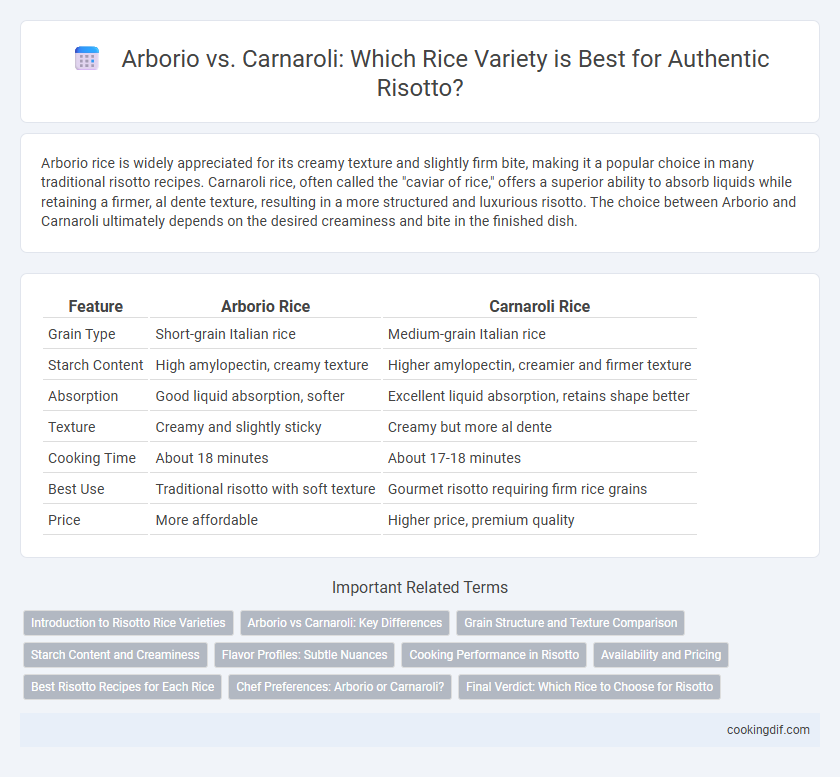Arborio rice is widely appreciated for its creamy texture and slightly firm bite, making it a popular choice in many traditional risotto recipes. Carnaroli rice, often called the "caviar of rice," offers a superior ability to absorb liquids while retaining a firmer, al dente texture, resulting in a more structured and luxurious risotto. The choice between Arborio and Carnaroli ultimately depends on the desired creaminess and bite in the finished dish.
Table of Comparison
| Feature | Arborio Rice | Carnaroli Rice |
|---|---|---|
| Grain Type | Short-grain Italian rice | Medium-grain Italian rice |
| Starch Content | High amylopectin, creamy texture | Higher amylopectin, creamier and firmer texture |
| Absorption | Good liquid absorption, softer | Excellent liquid absorption, retains shape better |
| Texture | Creamy and slightly sticky | Creamy but more al dente |
| Cooking Time | About 18 minutes | About 17-18 minutes |
| Best Use | Traditional risotto with soft texture | Gourmet risotto requiring firm rice grains |
| Price | More affordable | Higher price, premium quality |
Introduction to Risotto Rice Varieties
Arborio and Carnaroli are the two most popular rice varieties used in risotto, each offering distinct cooking characteristics. Arborio rice is known for its high starch content, which creates the classic creamy texture, while Carnaroli is prized for its firmer grain and superior absorption, resulting in a more al dente bite and enhanced flavor retention. Both varieties are essential in Italian cuisine, with Carnaroli often favored by chefs for professional risotto due to its ideal balance of creaminess and firmness.
Arborio vs Carnaroli: Key Differences
Arborio rice is known for its short, plump grains and high starch content, resulting in a creamy and slightly chewy risotto texture, while Carnaroli rice features longer grains with an even higher starch level that offers a firmer, more al dente bite and greater resistance to overcooking. Carnaroli is often favored by chefs for its superior ability to absorb flavors and maintain consistency during slow cooking, making it ideal for traditional Italian risotto dishes. Arborio is more widely available and budget-friendly, commonly used for everyday risotto recipes where a rich, creamy texture is desired.
Grain Structure and Texture Comparison
Arborio rice features a round, plump grain with a high starch content that releases creamy texture during cooking, ideal for traditional risotto consistency. Carnaroli grains are longer and firmer with a higher amylose content, providing better al dente texture and increased resistance to overcooking, preferred by chefs seeking precise texture control. The grain structure of Carnaroli supports a more resilient bite, while Arborio's starchiness contributes to a richer creaminess in risotto dishes.
Starch Content and Creaminess
Arborio rice contains a high level of amylopectin starch, which releases during cooking to create a creamy, slightly sticky texture ideal for traditional risotto. Carnaroli rice, often called the "caviar of rice," boasts an even higher starch content and firmer grain structure, resulting in a creamier and richer consistency while maintaining its shape better throughout the cooking process. The superior starch release of Carnaroli makes it preferred by chefs seeking maximum creaminess and texture contrast in risotto dishes.
Flavor Profiles: Subtle Nuances
Arborio rice offers a creamy texture with a mild, slightly sweet flavor ideal for traditional risottos, enhancing the dish's richness without overpowering other ingredients. Carnaroli, often referred to as the "King of Risotto," delivers a firmer bite and a more pronounced nutty aroma, providing subtle depth and complexity to the flavor profile. The nuanced difference in starch content between Arborio and Carnaroli creates distinct mouthfeel experiences, with Carnaroli maintaining its structure longer during slow cooking.
Cooking Performance in Risotto
Arborio rice offers a creamy texture and slightly firm bite, making it a popular choice for traditional risotto recipes. Carnaroli rice boasts higher starch content and firmer grains, resulting in a silkier, more stable consistency that holds up better during slow cooking. This makes Carnaroli preferred by chefs seeking optimal creaminess and texture control in risotto preparation.
Availability and Pricing
Arborio rice is widely available in most supermarkets and generally more affordable, making it a popular choice for casual risotto recipes. Carnaroli rice, known for its higher starch content and creamier texture, tends to be less common and priced at a premium due to its superior quality. Availability of Carnaroli can be limited outside specialty Italian markets, impacting its pricing and accessibility compared to the more ubiquitous Arborio variety.
Best Risotto Recipes for Each Rice
Arborio rice, known for its creamy texture and ability to absorb flavors, is ideal for classic Italian risotto recipes such as Risotto alla Milanese and mushroom risotto, where a balance between creaminess and bite is desired. Carnaroli rice, prized for its firmer grains and superior starch content, excels in gourmet risotto dishes like seafood risotto and truffle risotto, providing a more al dente texture that holds well during slow cooking. Choosing Arborio enhances traditional, comforting risottos, while Carnaroli elevates sophisticated recipes requiring precise texture and rich flavor absorption.
Chef Preferences: Arborio or Carnaroli?
Chefs often prefer Carnaroli rice for risotto due to its higher starch content and firmer texture, which yields a creamier yet al dente dish. Arborio rice, while more widely available and slightly quicker to cook, tends to absorb liquids faster but can become mushier if overcooked. Professional cooks favor Carnaroli for its superior consistency and ability to maintain individual grain integrity during slow cooking.
Final Verdict: Which Rice to Choose for Risotto
Carnaroli rice is often preferred by chefs for risotto due to its higher starch content and firm texture, which results in a creamier, more al dente dish. Arborio rice offers a slightly faster cooking time and is more widely available, making it a practical choice for home cooks. For optimal risotto, Carnaroli provides superior creaminess and structure, while Arborio delivers convenience without sacrificing too much quality.
Arborio vs Carnaroli for rice variety Infographic

 cookingdif.com
cookingdif.com